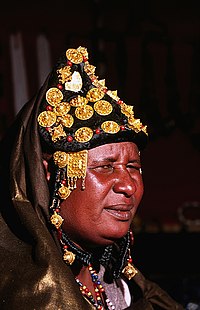
Back شعب سونجاى ARZ Songhais Catalan Songhai Danish Songhai German Sonhajoj Esperanto Songhai Spanish Songaid Estonian Songhai (herria) Basque Songhait Finnish Songhaïs French
 Songhai woman at a festival | |
| Total population | |
|---|---|
| c. 9.1 million | |
| Regions with significant populations | |
| West Africa | |
| 5,106,423 (21.2%) [1] | |
| 1,984,114 (5.9%) [2] | |
| 1,200,000 (0.5%) | |
| 406,000 (2.9%) [3] | |
| 241,000 (1.04%)[4] | |
| 110,000 (2.0%)[5] | |
| 50,000 (0.11%) | |
| 3,800 (0.01%)[citation needed] | |
| Languages | |
| Songhay languages, French, English, Arabic | |
| Religion | |
| Predominantly Muslim | |
| Related ethnic groups | |
| Tuareg, other Nilo-Saharan groups, Mandé, Soninke, Fula (in Niger and Mali), Hausa, (in Nigeria and Niger). | |
The Songhai people (autonym: Ayneha) are an ethnolinguistic group in West Africa who speak the various Songhai languages. Their history and lingua franca is linked to the Songhai Empire which dominated the western Sahel in the 15th and 16th century. Predominantly adherents of Islam, the Songhai are primarily located in Niger and Mali within the Western Sudanic region (not the country). Historically, the term "Songhai" did not denote an ethnic or linguistic identity but referred to the ruling caste of the Songhay Empire known as the Songhaiborai.[6] However, the correct term used to refer to this group of people collectively by the natives is "Ayneha".[7][8] Although some Speakers in Mali have also adopted the name Songhay as an ethnic designation,[9] other Songhay-speaking groups identify themselves by other ethnic terms such as Zarma (or Djerma, the largest subgroup) or Isawaghen. The dialect of Koyraboro Senni spoken in Gao is unintelligible to speakers of the Zarma dialect of Niger, according to at least one report.[10] The Songhay languages are commonly taken to be Nilo-Saharan but this classification remains controversial: Dimmendaal (2008) believes that for now it is best considered an independent language family.[11]
- ^ "Africa: Niger - The World Factbook - Central Intelligence Agency". www.cia.gov. 27 April 2021. Retrieved 1 May 2021.
- ^ "Africa: Mali - The World Factbook - Central Intelligence Agency". www.cia.gov. 27 April 2021. Retrieved 1 May 2021.
- ^ [1]
- ^ Sub-Saharan African Peoples, peoplegroups.org, retrieved 13 January 2024
- ^ 2021 Population and Housing Census, Ghana Statistical Service, Ministry of Finance, 2022, p. 70, retrieved 13 January 2024
{{citation}}: CS1 maint: location missing publisher (link) - ^ Stoller, Paul (1992), The Cinematic Griot: The Ethnography of Jean Rouch, University of Chicago Press, p. 59 "In this way the true Songhay, after the seventeenth century,is no longer the one of Timbuktu or Gao, but the one farther south near the Anzourou, the Gorouol, on the islands of the river surrounded by rapids" (Rouch 1953, 224), ISBN 9780226775487, retrieved 4 June 2021
- ^ Linguistics and Language Behavior Abstracts: LLBA., Volume 33, Issue 3, 1999, retrieved 14 May 2021
- ^ Etudes de lettres, Faculté des lettres de l'Université de Lausanne, 2002, retrieved 14 May 2021
- ^ Heath, Jeffrey. 1999. A grammar of Koyraboro (Koroboro) Senni: the Songhay of Gao. Köln: Köppe. 402 pp
- ^ "Niger". Ethnologue. Retrieved 4 November 2015.
- ^ Dimmendaal, Gerrit. 2008. Language Ecology and Linguistic Diversity on the African Continent. Language and Linguistics Compass 2(5): 843ff.
© MMXXIII Rich X Search. We shall prevail. All rights reserved. Rich X Search